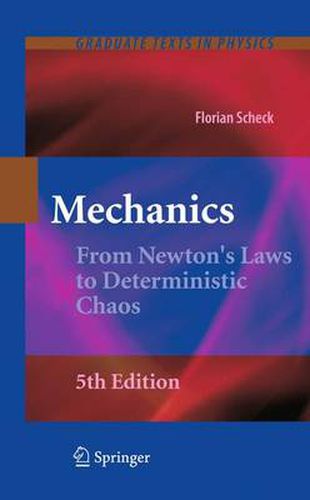Readings Newsletter
Become a Readings Member to make your shopping experience even easier.
Sign in or sign up for free!
You’re not far away from qualifying for FREE standard shipping within Australia
You’ve qualified for FREE standard shipping within Australia
The cart is loading…






This title is printed to order. This book may have been self-published. If so, we cannot guarantee the quality of the content. In the main most books will have gone through the editing process however some may not. We therefore suggest that you be aware of this before ordering this book. If in doubt check either the author or publisher’s details as we are unable to accept any returns unless they are faulty. Please contact us if you have any questions.
Purpose and Emphasis. Mechanics not only is the oldest branch of physics but was and still is the basis for all of theoretical physics. Quantum mechanics can hardly be understood, perhaps cannot even be formulated, without a good kno- edge of general mechanics. Field theories such as electrodynamics borrow their formal framework and many of their building principles from mechanics. In short, throughout the many modern developments of physics where one frequently turns back to the principles of classical mechanics its model character is felt. For this reason it is not surprising that the presentation of mechanics re?ects to some - tent the development of modern physics and that today this classical branch of theoretical physics is taught rather differently than at the time of Arnold S- merfeld, in the 1920s, or even in the 1950s, when more emphasis was put on the theoryandtheapplicationsofpartial-differentialequations. Today, symmetriesand invariance principles, the structure of the space-time continuum, and the geom- rical structure of mechanics play an important role. The beginner should realize that mechanics is not primarily the art of describing block-and-tackles, collisions of billiard balls, constrained motions of the cylinder in a washing machine, or - cycle riding.
$9.00 standard shipping within Australia
FREE standard shipping within Australia for orders over $100.00
Express & International shipping calculated at checkout
This title is printed to order. This book may have been self-published. If so, we cannot guarantee the quality of the content. In the main most books will have gone through the editing process however some may not. We therefore suggest that you be aware of this before ordering this book. If in doubt check either the author or publisher’s details as we are unable to accept any returns unless they are faulty. Please contact us if you have any questions.
Purpose and Emphasis. Mechanics not only is the oldest branch of physics but was and still is the basis for all of theoretical physics. Quantum mechanics can hardly be understood, perhaps cannot even be formulated, without a good kno- edge of general mechanics. Field theories such as electrodynamics borrow their formal framework and many of their building principles from mechanics. In short, throughout the many modern developments of physics where one frequently turns back to the principles of classical mechanics its model character is felt. For this reason it is not surprising that the presentation of mechanics re?ects to some - tent the development of modern physics and that today this classical branch of theoretical physics is taught rather differently than at the time of Arnold S- merfeld, in the 1920s, or even in the 1950s, when more emphasis was put on the theoryandtheapplicationsofpartial-differentialequations. Today, symmetriesand invariance principles, the structure of the space-time continuum, and the geom- rical structure of mechanics play an important role. The beginner should realize that mechanics is not primarily the art of describing block-and-tackles, collisions of billiard balls, constrained motions of the cylinder in a washing machine, or - cycle riding.